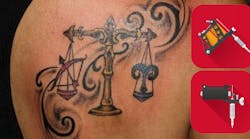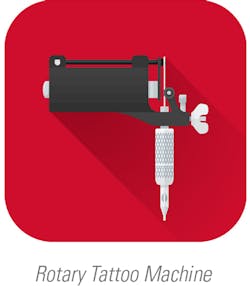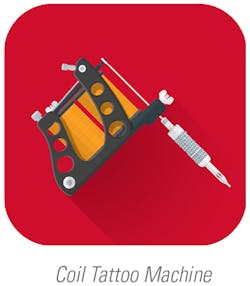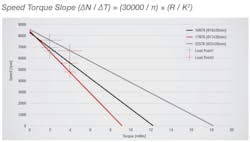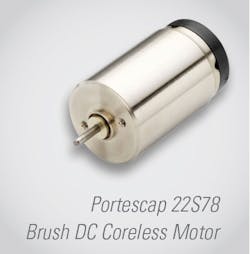As the art of tattoos has evolved, so have the machines designed to turn ink into living art.
The process requires reciprocating needles that repeatedly penetrate the dermal skin at a high rate of frequency. There are two types of commercially marketed tattoo machines: coil and rotary. They are so named for their construction and the way the mechanism operates.
A coil tattoo machine utilizes an electromagnetic circuit to provide linear motion to the needle. A conventional rotary tattoo machine uses an electric motor with a rotating shaft having an offset cam mechanism at its end. The cam is coupled perpendicularly or axially with the mechanism to provide linear motion to the needle.
There actually are three types of coloring strokes used by the tattoo artist:
- Lining: A single needle is used to penetrate the skin.
- Shading: Multiple needles simultaneously penetrate the skin.
- Coloring: A greater number of needles than shading.
In each stage, the throw needs to be greater than the previous stage to achieve proper skin penetration by the needles.
This is why many tattoo artists carry three machines, each set for the specific strokes. While this eliminates the need to readjust the rotary tattoo machine for each stage, it also requires the three machines need to be purchased, maintained, and cleaned after each job.
New-generation machines have a mechanism with added features that can adjust stroke, speed, and forces which allow one machine to cover all three strokes, in addition to being effective on all types of skin textures.
New-generation rotary tattoo machines allow lining, shading, and coloring to be done by adjusting stroke length (cam change), speed (voltage change), and force (spring force setting). These new feature settings are responsible for variable load amplitude with variable frequencies on the motor.
In newly designed “pen type” tattoo machines, the mechanism and needle arrangement are in line in a cylindrical casing, offering an ergonomic design for the tattoo artist. Pen type tattoo machines are easy to maneuver. Also, manufacturers have been developing more efficient and compact machines, which are ideal for battery-powered applications.
The new generation of battery-operated machines being developed by manufacturers will be compact, lightweight, and portable. These can be used anywhere, at any location.
The Importance of Bearings
In a cam-slider mechanism, the rotating motion is converted into linear motion, which reciprocates the needle at a high frequency and speed. During this operation, the cyclic radial load comes onto the motor shaft through the cam. This load is ultimately transferred onto the bearing which is at some distance from the cam. Based on the designed distance between the cam and the bearing, the radial load on the bearing is calculated and the motor is designed to withstand the radial load on the bearing.
In tattoo machines, the dominant failure mode for motors is the bearing failure due to poor design of the mechanism or the wrong choice of the bearing for the amount of reaction axial or radial loads. This generally leads to the wear of bearing balls or one of the bearing races.
The first indicator of a bearing failure in tattoo machines is either an increase in vibration felt by the artist or an increase in the motor noise due to the wear of bearings. In most cases, an increase in vibration is soon followed by an increase in noise until, finally, the motor fails.
Bearing life associated with 90% reliability (L10) is as follows:
Impact of Various Mechanisms on Motors
In a tattoo machine, the load is typically 3 N to 9 N. It acts radially or axially on the bearing depending on the nature of the mechanism. Also, there is constant axial preload of 1 N to 3 N acting on the bearing. The speed of the motor ranges from 4,000 rpm to 10,000 rpm. The life of the bearing is typically 1,000 to 1,500 hours, but it can vary depending on the mechanism, duty cycle, and handling of the tattoo machine.
Essential Motor Qualities for Tattoo Machines
Cyclic radial and axial load due to working of tattoo machines is directly transferred onto the motor shaft and bearing inner raceway contact. This cyclic load causes structure-borne vibration and resulting noise of the motor, which is not desirable. If the reciprocating vibration in the machine is high, it generally results in damaging the skin. This is because the pigment does not have the time to be absorbed by the epidermis when the tip of the needle reaches the end position.
To improve the diffusion of the color within the skin, the artist is often forced to apply more pressure to the tattoo machine and to incline it, increasing the penetration of the needle and accordingly the pain of the person receiving the tattoo, as well as causing more trauma to the skin.
It falls on the motor designer as well as the driving mechanism for proper selection of bearing, designing the mechanism for distributing the reciprocating load on the motor shaft, and preloading the bearing properly. The motor should have sufficient torque and speed (i.e., power) to get proper lining, coloring, and shading for good-quality tattoos. Insufficient speed and torque cause vibrations, which does not allow the coloring liquid to spread within the skin uniformly.
Motor regulation (R/K2) is the critical parameter of the motor which defines the speed torque characteristics. The lower the motor regulation, the more powerful the motor. As the torque (load) increases, the speed decreases. If the motor regulation is better, then there is less speed drop with the increase in load. This gives better stability for tattooing, as there is less speed variation with respect to load, resulting in less vibration and noise of the tattoo machine.
Less vibration results in better quality tattooing and easier healing, as well as less fatigue in the artist’s hand. Good motor regulation gives the motor high power density, meaning less power losses and better efficiency.
Driving Greater Efficiency
Efficiency is the critical parameter for next-generation tattoo machines, which will be battery-operated. Higher efficiency will result in less power losses and less current consumption, which will increase the battery life.
The motor should be compact in size for proper ergonomics and handling of the tattoo machine. The motor should also be lightweight to reduce the overall weight of tattoo machine, which will lead to less fatigue in the artist’s hand over time. This will be beneficial for longer tattooing sessions. A tattoo machine that is light and compact offers improved diffusion of the coloring liquid in the skin, simplifies the tasks of the artist, reduces the pain caused by the piercing action, and increases its safety for the customer.
In motors, the joint between the shaft and bearing is critical because of the cyclic axial and radial load of the tattoo machine. The preloading of the bearing and the rigid shaft-bearing joint should be optimized to withstand these load cycles. Hence, Portescap motors produce lower noise and increased reliability in tattoo machines.
As tattooing continues to grow in popularity every year, rotary tattoo machine manufacturers have been developing new machines with additional features to improve and enhance the process. The most critical aspect of these new machines is the motor. It should deliver the required performance, as it is the prime mover—sustaining all the reciprocating loads created by the mechanism. Motor performance and reduced noise should also be considered, as these are the key quality parameters for motor and machine reliability.
As new generation machines continue to develop, so too does the demand for motor customization. Compact and lightweight motors with high power density are at the heart of every new generation tattoo machine.
Other applications and advantages of precision coreless DC miniature motors:
Insulin and infusion pump. Coreless DC motor gives high efficiency, hence less current consumption to increase the battery life. Coreless DC motors are compact in size and lighter, which reduces overall weight of the pump. It gives lower noise which is desired in pump application. It also gives precise speed torque gradient desired for insulin delivery. Hence coreless DC miniature motors are need of medical applications where human health and safety is critical.
Robotic. For movement of joints, motors are used. Coreless DC miniature motors has low inertia; hence it gives high acceleration and good controllability for robotic movements.
Lab automation. For applications like frame measurement machine, low inertia and precise position is desired for measurement. Coreless DC motor is capable for these requirements. It also gives fast and easy measurement with good repeatability.
Aerospace. Applications like window shade actuator in planes’ coreless DC motors are used. It can satisfy electromagnetic interference (EMI) and electromagnetic compatibility (EMC) requirements. Also, there is need for good acceleration with good controllability.
Hand tools. In various hand tools like electric screw drivers and pruning shears, a coreless DC motor is required. It requires a compact motor, which could also give high acceleration and high torque.
Defense applications. In various defense applications like missile fin actuators, and torpedo launchers, missile launcher coreless DC motors are used. High power density and less torque ripples make coreless DC motors suitable for these kind of applications.
Vishal Sapale is assistant manager - design engineering, R&D for Westchester, Pa.-based Portescap. To contact an engineer, click here.
